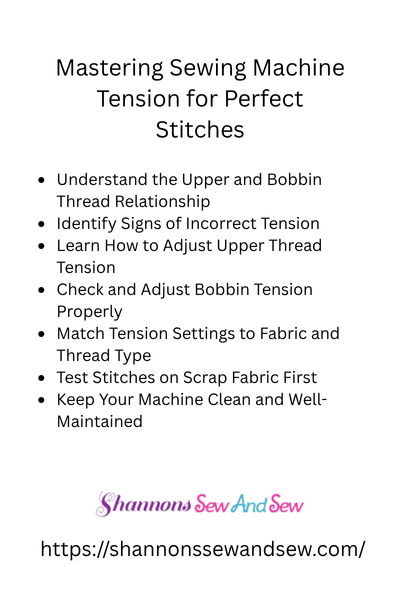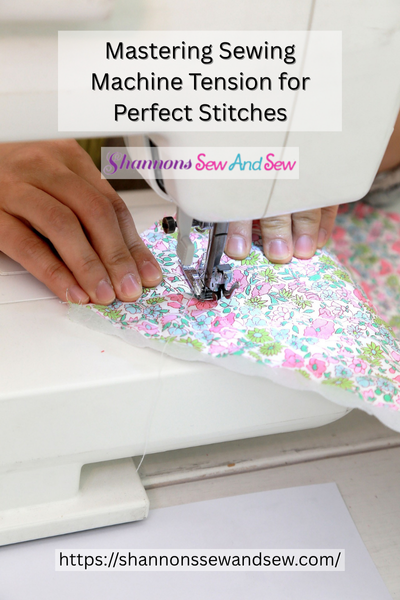Sewing For Beginners
Mastering Sewing Machine Tension for Perfect Stitches
Let’s talk about something that drove me nuts when I first started sewing: mastering sewing machine tension for perfect stitches. If you’ve ever stared at a bird’s nest of thread under your fabric and asked the heavens, “What did I do to deserve this?”—yeah, same.
I remember the first time my sewing machine went rogue. I was making a pair of cargo pants (yes, for myself—I’m not ashamed), and halfway through, the stitches started looking like spaghetti. Top thread too tight. Bottom thread too loose. It was chaos. I fiddled with every dial, cursed a little, and finally realized: I didn’t really understand tension at all.
Read More About Mastering Sewing Machine Tension for Perfect Stitches

So, What Is Tension Anyway?
Think of sewing machine tension like a tug-of-war between your top and bottom threads. The goal? A perfectly balanced pull. If either side tugs too hard, your stitches will go wonky—looping, puckering, skipping… you name it.
When you’re mastering sewing machine tension for perfect stitches, you’re really learning how to keep that tug-of-war fair and square.
If the top tension is too tight, you’ll see the bottom thread pulled up into ugly loops. Too loose? The top thread droops underneath like it’s given up. And don’t get me started on bobbin tension—it’s the underdog that’s often overlooked but super important.
More Things to Know About Mastering Sewing Machine Tension for Perfect Stitches

That Tension Dial Isn’t Just for Show
You’d be surprised how many people think the tension dial is just… decoration. But nope—it’s your best friend once you get to know it.
Most machines come with settings from 0 to 9. I usually start around 4 and adjust from there. But here’s the kicker: different fabrics, threads, and even needles can change what “perfect” tension looks like.
Sewing denim? You might need to crank that dial up a bit. Lightweight cotton? Dial it down. Testing on a scrap piece before you commit to your project is always a smart move (trust me, learned that one the hard way).
Bobbin Tension Deserves Some Love, Too
Alright, bobbin tension. I used to ignore this completely, thinking, “It’s in a case, it’ll be fine.” Spoiler alert: it wasn’t. When I started messing with the little screw on my bobbin case (very carefully, mind you), everything changed.
Now, I’m not saying you need to adjust it all the time. But when nothing else works and you’re still not getting clean stitches, the bobbin might be trying to tell you something.
Don’t Forget the Thread (It’s Not All on You)
I once bought a bargain-bin thread that looked okay but turned my machine into a disaster zone. Turns out, cheap thread can cause tension nightmares. It breaks, it frays, it messes with the flow.
So when you’re mastering sewing machine tension for perfect stitches, make sure your thread’s up for the job. Good-quality thread might cost a bit more, but it’ll save you hours of frustration.
And while we’re at it—check your needle, too. A dull or bent needle can totally mess up your tension game.
The Test Stitch Trick
Here’s a habit I’ve picked up that I swear by: every time I switch fabrics or threads, I sew a quick test line on a scrap. If I see loops or puckers, I tweak the tension and try again. This tiny step has saved so many projects (and my sanity).
Troubleshooting Without Losing Your Mind
Okay, real talk—figuring out tension issues can be maddening. But here’s how I break it down:
- First, check your threading. Rethread both the top and bobbin completely.
- Then, clean out any lint from the bobbin area (you’d be amazed how much builds up).
- Next, test with a straight stitch on medium speed.
- Adjust one thing at a time—start with top tension. Only touch the bobbin if nothing else works.
And breathe. You’re not breaking your machine, you’re learning to control it. Like taming a tiny metal beast.
The Confidence Boost
Once I finally got the hang of tension, sewing became fun. I wasn’t second-guessing every seam. I felt more in control, more creative. That confidence spilled over into my projects—and I swear they started looking better, too.
Getting to Know Your Sewing Machine One Stitch at a Time
You don’t need to be a sewing wizard to get this right—you just need a little patience and a lot of curiosity. Mastering sewing machine tension for perfect stitches isn’t about memorizing some magic number. It’s about understanding how your machine feels when it’s working right.
So next time your stitches look a little off, don’t panic. Tension is totally fixable. Play with the dial. Test your thread. Talk to your machine (it helps, I swear). With a bit of trial and error, you’ll be nailing those stitches—and loving the process.
And hey, if you ever need moral support mid-seam rip, you know where to find me.




















